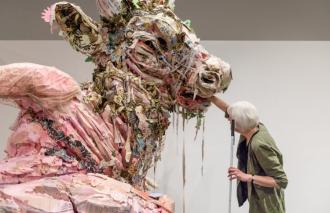For some people, art and blindness are often thought of as incompatible. But blindness itself can be “a variety of visual experience,” UC Berkeley lecturer Georgina Kleege remarks in an interview with The Daily Californian. Even sighted people have various levels of visual ability, with congenital blindness at one end of the spectrum.
Kleege identifies herself as legally blind with some residual vision. She was diagnosed legally blind at age 11 with her vision declining until her 20s. Her knowledge of art grew from a childhood spent in art studios, museums and galleries and from parents who were visual artists. Kleege is the author of the book “More than Meets the Eye: What Blindness Brings to Art.”
Kleege teaches both creative writing and disability studies at UC Berkeley and is devoted to understanding blindness in the context of visual art and expression. For instance, she points to the fact that people often invoke blindness as an opposite to visual art.
“(The word ‘blind’) would be used as a metaphor, as a synonym for ignorance, for obliviousness or prejudice,” Kleege says.
The downside is that the visually impaired person grows up in a world where the word “blind” has negative connotations, which can cause long-lasting psychological effects. Kleege says this directly impacts the way they perceive themselves, their capabilities and their role in the world.
Kleege points out that there is really no quick way of overturning a centuries-old language convention. Rather than telling everyone to not use the word “blind,” her advice is to be aware of the context of its use. It is appropriate to use it when referring to a visually impaired person. But when using the word interchangeably with terms such as “prejudiced” or “oblivious,” being blind is then associated with being ignorant.
In addition to the intersection of blindness and art, Kleege also discussed how technical assistance for blind people on campus can often be impractical. For example, she spoke of how braille numbers on elevator buttons allow you to choose a floor, but there needs to be a second sign or audio signal that indicates you have reached your desired floor. Similarly, there is no braille signage giving directions to the offices on each floor of campus buildings.
Becoming aware of other prominent blind artists inspired Kleege in her pursuit of demystifying art and blindness. Many of these artists had continued art even after losing their vision. She feels that their loss of sight could well have enhanced their representation of vision in their art.
“I think the important thing to think about in visual art is that artists are not just making pictures of what they see. They are using a visual language to communicate. So it’s not like they see themselves as a camera. … But they are using their skills … to make images that say something beyond documentation of their vision and/or their visual impairment,” Kleege says.
The motivation behind Kleege’s work started with her curiosity as to the effectiveness of the programs for the blind that are traditionally offered by museums around the world. Museums have, however, been reluctant for viewers to touch art pieces on display, which posed a challenge in her efforts to promote widespread “touch tours” for blind viewers.
Kleege is also working on improving the lexicon used to describe art so that it reflects tactile and emotional experiences that a blind person can relate to. For instance, Kleege worked on the “Haptic Encounters” project last year at the Contemporary Jewish Museum in San Francisco. There, she was allowed to touch the art and give narrations of that experience. This essentially expanded the sensory art experience even for the sighted viewer.
In the coming year, Kleege will co-curate an exhibit called “Please Touch the Art,” where every work of art is meant to be touched by all viewers. What is different is that artists submitting work for this exhibit will also be asked to describe the unique experience of touching their art.
October is Disability Awareness Month, yet raising awareness of disability issues is still very much a work in progress. For Kleege, disability is just another facet of the human condition. The message Kleege would like to focus on is that “disability is a diversity category” and should not be understood as just a problem that can be addressed with a set of accommodations. “We also have to think about the benefit of inclusion that these accommodations make possible.”
Kleege goes on to add, “We have an understanding that diversity is something we value at Cal. Students with disabilities, faculty with disabilities bring a different perspective. … They can analyze things that people who are not disabled take for granted about the built environment, about classroom procedures, about communication, about aesthetics.”
Ultimately, what Kleege would like celebrated — not just this month but always — is that inclusion of people with disabilities is a win-win for both the disabled and non-disabled.
